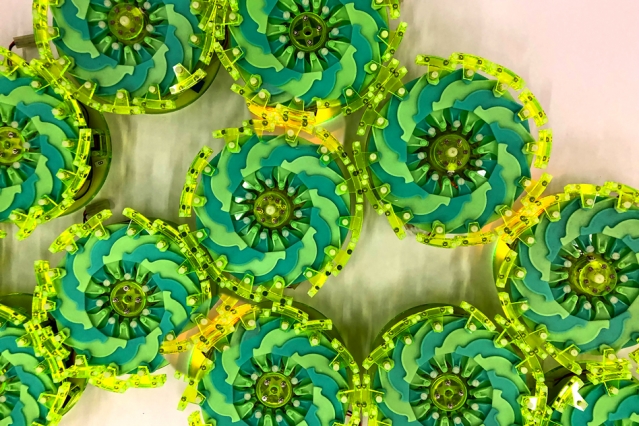
MIT researchers have developed Particle Robotics, a new form of simple robotics that do not need to communicate directly with each other to move in unison and will continue to move even if a large portion of the system is destroyed.
The system comprises individual cells or disc-shaped “particles” that interconnect to form a larger system of devices that can transport objects. Each individual robot is roughly six inches in size and can do only two things, expand and contract.
When several devices are side by side their expansion and contraction is timed so they move like a wave in a chosen direction, in this case towards a light source which is integral to the synchronised motion of the particles.
Importantly the devices do not directly communicate which each other, instead they broadcast what level of light intensity they are detecting. With this data an algorithm programmed into each device times an expansion and contraction which propels the mass of robots towards the light source moving any object along with them.
Hod Lipson, a professor of mechanical engineering at Columbia Engineering, commented in a blog on the technology that: “The key novelty here is that you have a new kind of robot that has no centralized control, no single point of failure, no fixed shape, and its components have no unique identity.”
Particle Robotics Are Incredibly Robust
Each device consists of a six inch cylindrical bases that contains a battery, a motor, a microcontroller, light detection sensors and a communication module that can broadcast and receive signals. Every particle has magnets on the side panel that allow it to interconnect with other particles.
A device on its own will not be able to move, but several linked together enable them to move via expanding and contracting. In order for them to move in a chosen direction the scientists equipped each device with an algorithm that analyses broadcasted information being sent out constantly by each particle. These broadcasts contain data on the level of light intensity each particle is detecting rated on a scale of one to ten.
The result is a synchronized system that will move away or towards a designated light source. Shuguang Li a PostDoc researcher at the Computer Science and Artificial Intelligence Laboratory (CSAIL) commented: “This creates a mechanical expansion-contraction wave, a coordinated pushing and dragging motion, that moves a big cluster toward or away from environmental stimuli,
You could destroy a number of the devices in the swarm and it would not stop their functionality. In a paper published in Nature the researchers noted that they ran a simulation in which a cluster of 10,000 particles maintain their course and motion, even though 20 percent of the devices had failed.
Daniela Rus director of CSAIL wrote that: “The robot by itself is static, but when it connects with other robot particles, all of a sudden the robot collective can explore the world and control more complex actions. With these ‘universal cells,’ the robot particles can achieve different shapes, global transformation, global motion, global behaviour, and, as we have shown in our experiments, follow gradients of light. This is very powerful.”
With further development size scaling the system could represent a new form of robust micro-robotics that ensure sustained working systems less prone to complete shut down due to damaged parts. The particles have been developed in a collaborative project between MIT, Columbia Engineering, Cornell University, and Harvard University researchers.






